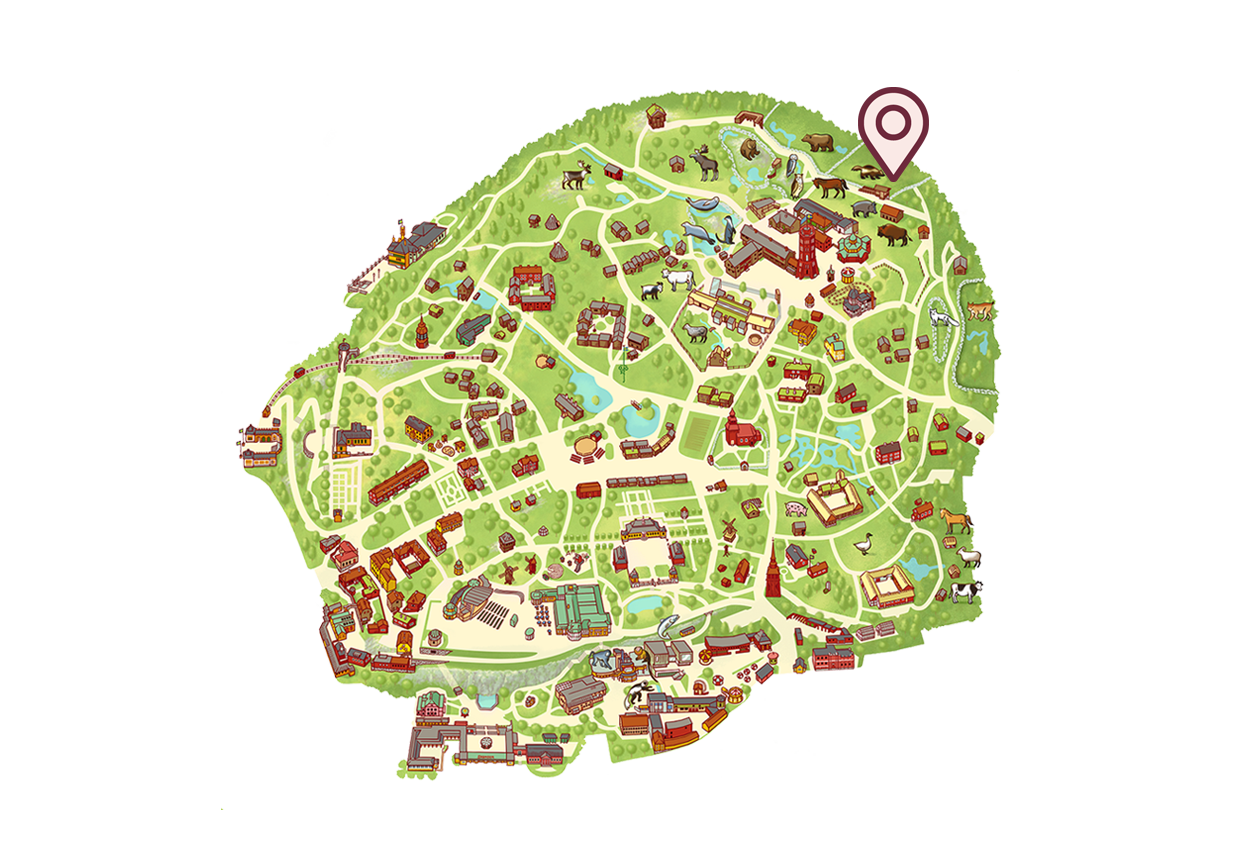- See and do
- The Zoo
- Animals at Skansen
- Wolverine
Wolverine
The wolverine is a member of the weasel family and lives in northern Sweden. It is a predator that hunts for its food, but often has to make do with left-overs from the prey of animals such as lynx, wolves and bears.
-
The wolverine is the world’s largest land-dwelling mustelid. It is a solitary animal, meaning that it lives alone, and in Sweden it is found almost exclusively in reindeer herding areas.
-
Faktaruta om järv
Scientific name:Gulo gulo
Order:Predators (Carnivora)
Family:Mustelids (Mustelidae)
Weight:Males approx. 16 kg, females approx. 10 kg
Length:70–85 cm, plus a tail of approx. 20 cm
Sexual maturity:Approx. 2 years
Breeding season:April to August, usually June
Gestation:Approx. 2 months
Number of young:1–4, usually 2–3
Lifespan:6–12 years, or longer in animal parks
Eats:Both animals and plants
Distribution in Sweden:From Dalarna northwards
-
It was previously known in Sweden as the ‘mountain cat’. The Old Norse name lives on in today’s German name, Vielfraß, meaning ‘glutton’. The French name, glouton, has the same meaning. In Sweden, it has been called järv, meaning ‘brown’, since the 18th century.
Small head but large paws
The wolverine has dark brown fur and a small head with small ears. It has short legs, a long bushy tail and large paws in relation to its body size, allowing it to run on top of the snow without sinking. An adult male wolverine weighs about 16 kilograms, while an adult female weighs about 10 kilograms.
It moves with a distinctive jogging gallop. The wolverine is fast, running at speeds of up to 45 kilometres per hour. It uses its large paws to run on top of the snow without sinking. A healthy wolverine can run for sixty kilometres without resting.
A mediocre hunter that saves its prey
The shy wolverine has a reputation for being both gluttonous and cruel. Many people think it hunts just because it enjoys killing, but the wolverine is only a mediocre hunter. It mainly eats carrion, in other words dead animals or animals that other predators have already killed. However, when the hunting conditions are good – with hard snow crust, or loose snow that supports its broad paws while reindeer sink down – the wolverine can bring down large numbers of prey which it dismembers, hides and eats later. Good hunting conditions allow the wolverine to kill many reindeer, which naturally creates conflicts with humans. The wolverine lives alone and can roam for long distances, often following the movements of the reindeer.
Found mainly in mountains ranges
The wolverine is found throughout the tundra and taiga forest belts of the northern hemisphere, in Europe, Asia and North America. In Europe, it is only found in Russia, Finland and Scandinavia. It is mainly found in mountain ranges, as well as in woodlands and on marshland. It is a shy creature, preferring large, preferably uninhabited areas with unspoilt nature.
Gives birth every other year
Compared to lynx and wolves, the wolverine has a low reproduction rate. A female wolverine does not give birth to her first litter until she is three or four years old. After that, she usually gives birth only every other year. The female is the sole carer for the young kits, which stay with their mother for about a year before moving on to their own territory.
The home range is about 300 square metres for a male and about 100 square metres for a female. A male’s territory may overlap with that of several females. Access to food generally determines the size of the territory. If food is scarce, a larger territory is needed. It marks its territory by rubbing its hind quarters against the ground to release secretions from its scent glands. The male wolverine has a territory that it defends against other wolverines.
Protected, but recovering
The wolverine was made a protected species in 1969, meaning that it cannot be hunted except in connection with wildlife management hunting. Today, the biggest threat to the wolverine population is illegal hunting.
Since being protected, the wolverine population has slowly recovered from around a hundred to roughly 600 today.
The wolverine is classified as ‘Vulnerable’ on the Swedish Species Information Centre’s red list (in Swedish).
-
The wolverine in folklore
The wolverine has always been associated with myths. In his 1555 book ‘A Description of the Northern Peoples’, Olaus Magnus described the wolverine as being so greedy that it ate so much that its stomach stood out like a drum skin. It then approached two trees that stood close together and squeezed its way through, thereby emptying its stomach, before continuing to eat. The only time a wolverine could be shot was when it was found by trees.
The wolverine was previously believed to be associated with evil, and in some places people were scared to depict or kill wolverines. Hunting dogs had difficulty hunting wolverines because they passed such strong smelling gas.
You can find the wolverine here
